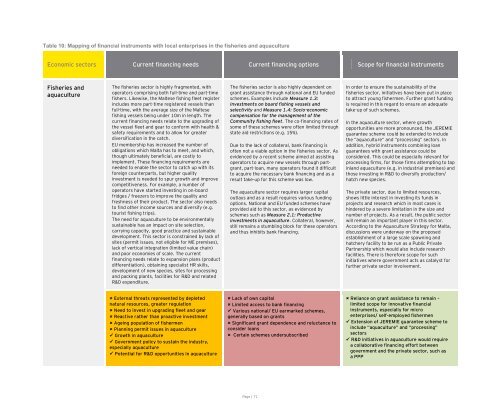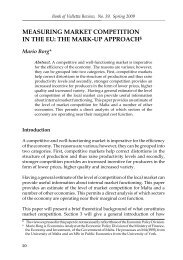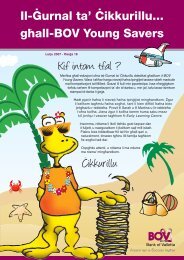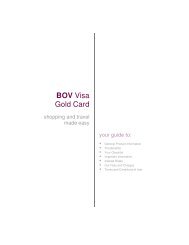Market Gaps on Access to Finance - Bank of Valletta
Market Gaps on Access to Finance - Bank of Valletta
Market Gaps on Access to Finance - Bank of Valletta
Create successful ePaper yourself
Turn your PDF publications into a flip-book with our unique Google optimized e-Paper software.
Table 10: Mapping <strong>of</strong> financial instruments with local enterprises in the fisheries and aquaculture<br />
Ec<strong>on</strong>omic sec<strong>to</strong>rs Current financing needs Current financing opti<strong>on</strong>s Scope for financial instruments<br />
Fisheries and<br />
aquaculture<br />
The fisheries sec<strong>to</strong>r is highly fragmented, with<br />
opera<strong>to</strong>rs comprising both full-time and part-time<br />
fishers. Likewise, the Maltese fishing fleet register<br />
includes more part-time registered vessels than<br />
full-time, with the average size <strong>of</strong> the Maltese<br />
fishing vessels being under 10m in length. The<br />
current financing needs relate <strong>to</strong> the upgrading <strong>of</strong><br />
the vessel fleet and gear <strong>to</strong> c<strong>on</strong>form with health &<br />
safety requirements and <strong>to</strong> allow for greater<br />
diversificati<strong>on</strong> in the catch.<br />
EU membership has increased the number <strong>of</strong><br />
obligati<strong>on</strong>s which Malta has <strong>to</strong> meet, and which,<br />
though ultimately beneficial, are costly <strong>to</strong><br />
implement. These financing requirements are<br />
needed <strong>to</strong> enable the sec<strong>to</strong>r <strong>to</strong> catch up with its<br />
foreign counterparts, but higher quality<br />
investment is needed <strong>to</strong> spur growth and improve<br />
competitiveness. For example, a number <strong>of</strong><br />
opera<strong>to</strong>rs have started investing in <strong>on</strong>-board<br />
fridges / freezers <strong>to</strong> improve the quality and<br />
freshness <strong>of</strong> their product. The sec<strong>to</strong>r also needs<br />
<strong>to</strong> find other income sources and diversify (e.g.<br />
<strong>to</strong>urist fishing trips).<br />
The need for aquaculture <strong>to</strong> be envir<strong>on</strong>mentally<br />
sustainable has an impact <strong>on</strong> site selecti<strong>on</strong>,<br />
carrying capacity, good practice and sustainable<br />
development. This sec<strong>to</strong>r is c<strong>on</strong>strained by lack <strong>of</strong><br />
sites (permit issues, not eligible for ME premises),<br />
lack <strong>of</strong> vertical integrati<strong>on</strong> (limited value chain)<br />
and poor ec<strong>on</strong>omies <strong>of</strong> scale. The current<br />
financing needs relate <strong>to</strong> expansi<strong>on</strong> plans (product<br />
differentiati<strong>on</strong>), obtaining specialist HR skills,<br />
development <strong>of</strong> new species, sites for processing<br />
and packing plants, facilities for R&D and related<br />
R&D expenditure.<br />
External threats represented by depleted<br />
natural resources, greater regulati<strong>on</strong><br />
Need <strong>to</strong> invest in upgrading fleet and gear<br />
Reactive rather than proactive investment<br />
Ageing populati<strong>on</strong> <strong>of</strong> fishermen<br />
Planning permit issues in aquaculture<br />
Growth in aquaculture<br />
Government policy <strong>to</strong> sustain the industry,<br />
especially aquaculture<br />
Potential for R&D opportunities in aquaculture<br />
The fisheries sec<strong>to</strong>r is also highly dependent <strong>on</strong><br />
grant assistance through nati<strong>on</strong>al and EU funded<br />
schemes. Examples include Measure 1.3:<br />
Investments <strong>on</strong> board fishing vessels and<br />
selectivity and Measure 1.4: Socio-ec<strong>on</strong>omic<br />
compensati<strong>on</strong> for the management <strong>of</strong> the<br />
Community fishing fleet. The co-financing rates <strong>of</strong><br />
some <strong>of</strong> these schemes were <strong>of</strong>ten limited through<br />
state aid restricti<strong>on</strong>s (e.g. 15%).<br />
Due <strong>to</strong> the lack <strong>of</strong> collateral, bank financing is<br />
<strong>of</strong>ten not a viable opti<strong>on</strong> in the fisheries sec<strong>to</strong>r. As<br />
evidenced by a recent scheme aimed at assisting<br />
opera<strong>to</strong>rs <strong>to</strong> acquire new vessels through partgrant,<br />
part-loan, many opera<strong>to</strong>rs found it difficult<br />
<strong>to</strong> acquire the necessary bank financing and as a<br />
result take-up for this scheme was low.<br />
The aquaculture sec<strong>to</strong>r requires larger capital<br />
outlays and as a result requires various funding<br />
opti<strong>on</strong>s. Nati<strong>on</strong>al and EU funded schemes have<br />
provided aid <strong>to</strong> this sec<strong>to</strong>r, as evidenced by<br />
schemes such as Measure 2.1: Productive<br />
investments in aquaculture. Collateral, however,<br />
still remains a stumbling block for these opera<strong>to</strong>rs<br />
and thus inhibits bank financing.<br />
Lack <strong>of</strong> own capital<br />
Limited access <strong>to</strong> bank financing<br />
Various nati<strong>on</strong>al/ EU earmarked schemes,<br />
generally based <strong>on</strong> grants<br />
Significant grant dependence and reluctance <strong>to</strong><br />
c<strong>on</strong>sider loans<br />
Certain schemes undersubscribed<br />
Page | 71<br />
In order <strong>to</strong> ensure the sustainability <strong>of</strong> the<br />
fisheries sec<strong>to</strong>r, initiatives have been put in place<br />
<strong>to</strong> attract young fishermen. Further grant funding<br />
is required in this regard <strong>to</strong> ensure an adequate<br />
take-up <strong>of</strong> such schemes.<br />
In the aquaculture sec<strong>to</strong>r, where growth<br />
opportunities are more pr<strong>on</strong>ounced, the JEREMIE<br />
guarantee scheme could be extended <strong>to</strong> include<br />
the “aquaculture” and “processing” sec<strong>to</strong>rs. In<br />
additi<strong>on</strong>, hybrid instruments combining loan<br />
guarantees with grant assistance could be<br />
c<strong>on</strong>sidered. This could be especially relevant for<br />
processing firms, for those firms attempting <strong>to</strong> tap<br />
inland aquaculture (e.g. in industrial premises) and<br />
those investing in R&D <strong>to</strong> diversify producti<strong>on</strong>/<br />
hatch new species.<br />
The private sec<strong>to</strong>r, due <strong>to</strong> limited resources,<br />
shows little interest in investing its funds in<br />
projects and research which in most cases is<br />
hindered by a severe limitati<strong>on</strong> in the size and<br />
number <strong>of</strong> projects. As a result, the public sec<strong>to</strong>r<br />
will remain an important player in this sec<strong>to</strong>r.<br />
According <strong>to</strong> the Aquaculture Strategy for Malta,<br />
discussi<strong>on</strong>s were underway <strong>on</strong> the proposed<br />
establishment <strong>of</strong> a large scale spawning and<br />
hatchery facility <strong>to</strong> be run as a Public Private<br />
Partnership which would also include research<br />
facilities. There is therefore scope for such<br />
initiatives where government acts as catalyst for<br />
further private sec<strong>to</strong>r involvement.<br />
Reliance <strong>on</strong> grant assistance <strong>to</strong> remain –<br />
limited scope for innovative financial<br />
instruments, especially for micro<br />
enterprises/ self-employed fishermen<br />
Extensi<strong>on</strong> <strong>of</strong> JEREMIE guarantee scheme <strong>to</strong><br />
include “aquaculture” and “processing”<br />
sec<strong>to</strong>rs<br />
R&D initiatives in aquaculture would require<br />
a collaborative financing effort between<br />
government and the private sec<strong>to</strong>r, such as<br />
a PPP







